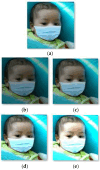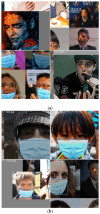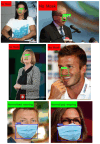Deep Learning-Based Biomimetic Identification Method for Mask Wearing Standardization
- PMID: 39329585
- PMCID: PMC11430216
- DOI: 10.3390/biomimetics9090563
Deep Learning-Based Biomimetic Identification Method for Mask Wearing Standardization
Abstract
Deep learning technology can automatically learn features from large amounts of data, with powerful feature extraction and pattern recognition capabilities, thereby improving the accuracy and efficiency of object detection. [The objective of this study]: In order to improve the accuracy and speed of mask wearing deep learning detection models in the post pandemic era, the [Problem this study aimed to resolve] was based on the fact that no research work has been reported on standardized detection models for mask wearing with detecting nose targets specially. [The topic and method of this study]: A mask wearing normalization detection model (towards the wearing style exposing the nose to outside, which is the most obvious characteristic of non-normalized style) based on improved YOLOv5s (You Only Look Once v5s is an object detection network model) was proposed. [The improved method of the proposed model]: The improvement design work of the detection model mainly includes (1) the BottleneckCSP (abbreviation of Bottleneck Cross Stage Partial) module was improved to a BottleneckCSP-MASK (abbreviation of Bottleneck Cross Stage Partial-MASK) module, which was utilized to replace the BottleneckCSP module in the backbone architecture of the original YOLOv5s model, which reduced the weight parameters' number of the YOLOv5s model while ensuring the feature extraction effect of the bonding fusion module. (2) An SE module was inserted into the proposed improved model, and the bonding fusion layer in the original YOLOv5s model was improved for better extraction of the features of mask and nose targets. [Results and validation]: The experimental results indicated that, towards different people and complex backgrounds, the proposed mask wearing normalization detection model can effectively detect whether people are wearing masks and whether they are wearing masks in a normalized manner. The overall detection accuracy was 99.3% and the average detection speed was 0.014 s/pic. Contrasted with original YOLOv5s, v5m, and v5l models, the detection results for two types of target objects on the test set indicated that the mAP of the improved model increased by 0.5%, 0.49%, and 0.52%, respectively, and the size of the proposed model compressed by 10% compared to original v5s model. The designed model can achieve precise identification for mask wearing behaviors of people, including not wearing a mask, normalized wearing, and wearing a mask non-normalized.
Keywords: BottleneckCSP; HSV space; artificial intelligence; mask; post-COVID-19 era; se module.
Conflict of interest statement
The authors declare no conflicts of interest.
Figures


















Similar articles
-
SMD-YOLO: An efficient and lightweight detection method for mask wearing status during the COVID-19 pandemic.Comput Methods Programs Biomed. 2022 Jun;221:106888. doi: 10.1016/j.cmpb.2022.106888. Epub 2022 May 13. Comput Methods Programs Biomed. 2022. PMID: 35598435 Free PMC article.
-
Face Mask-Wearing Detection Model Based on Loss Function and Attention Mechanism.Comput Intell Neurosci. 2022 Jul 12;2022:2452291. doi: 10.1155/2022/2452291. eCollection 2022. Comput Intell Neurosci. 2022. PMID: 35865498 Free PMC article. Review.
-
A detection method of the rescue targets in the marine casualty based on improved YOLOv5s.Front Neurorobot. 2022 Nov 16;16:1053124. doi: 10.3389/fnbot.2022.1053124. eCollection 2022. Front Neurorobot. 2022. PMID: 36467570 Free PMC article.
-
Accurate and fast detection of tomatoes based on improved YOLOv5s in natural environments.Front Plant Sci. 2024 Jan 11;14:1292766. doi: 10.3389/fpls.2023.1292766. eCollection 2023. Front Plant Sci. 2024. PMID: 38273960 Free PMC article.
-
Deep learning techniques for detecting and recognizing face masks: A survey.Front Public Health. 2022 Sep 26;10:955332. doi: 10.3389/fpubh.2022.955332. eCollection 2022. Front Public Health. 2022. PMID: 36225777 Free PMC article. Review.
References
-
- Wang C., Wang H., Han Q., Zhang Z., Kong D., Zou X. Strawberry Detection and Ripeness Classification Using YOLOv8+ Model and Image Processing Method. Agriculture. 2024;14:751. doi: 10.3390/agriculture14050751. - DOI
-
- Liu M., Cui M., Wei W., Xu X., Sun C., Li F., Song Z., Lu Y., Zhang J., Tian F., et al. Sorting of Mountage Cocoons Based on MobileSAM and Target Detection. Agriculture. 2024;14:599. doi: 10.3390/agriculture14040599. - DOI
-
- Lian X., Li Y., Wang X., Shi L., Xue C. Research on Identification and Location of Mining Landslide in Mining Area Based on Improved YOLO Algorithm. Drones. 2024;8:150. doi: 10.3390/drones8040150. - DOI
-
- He C., Wan F., Ma G., Mou X., Zhang K., Wu X., Huang X. Analysis of the Impact of Different Improvement Methods Based on YOLOV8 for Weed Detection. Agriculture. 2024;14:674. doi: 10.3390/agriculture14050674. - DOI
-
- Lu S., Chen W., Zhang X., Karkee M. Canopy-attention-YOLOv4-based immature/mature apple fruit detection on dense-foliage tree architectures for early crop load estimation. Comput. Electron. Agric. 2022;193:106696. doi: 10.1016/j.compag.2022.106696. - DOI
Grants and funding
LinkOut - more resources
Full Text Sources

